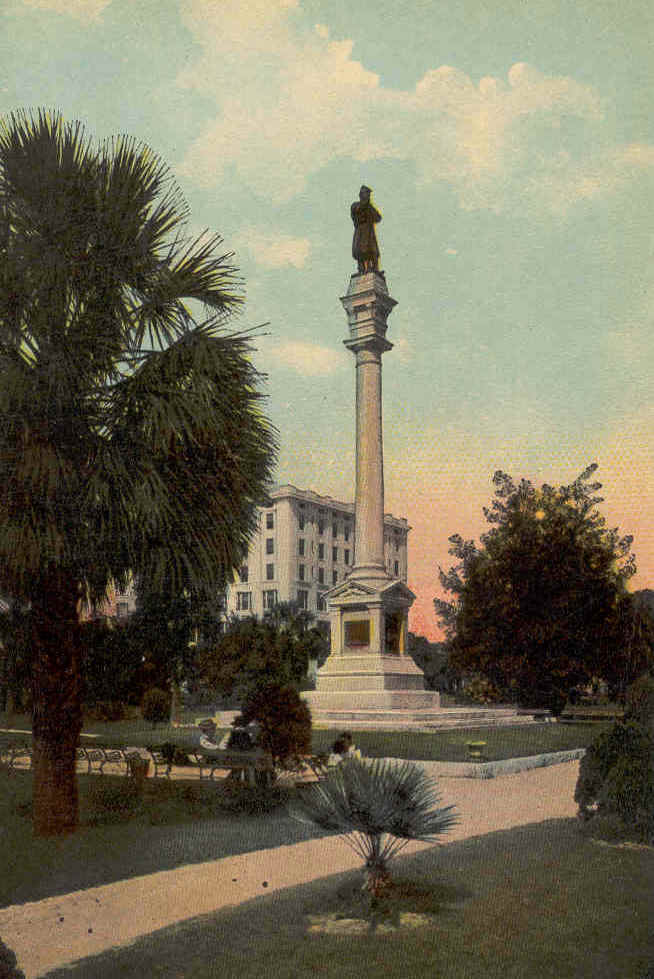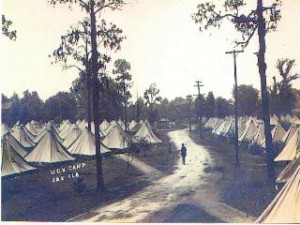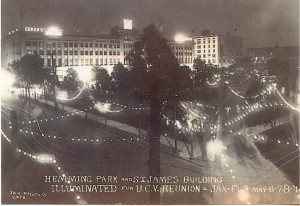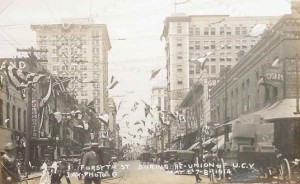Confederate Monument Hemming Park 1899

An occurrence in February 1896 brought lasting change to St. James Park. At the state reunion of United Confederate Veterans (UCV) in Ocala, Charles C. Hemming announced his plan to erect a memorial in honor of Florida’s Confederate soldiers. Members of the local Robert E. Lee Camp of Confederate Veterans immediately invited Hemming to a reception in Jacksonville, which was attended by many prominent citizens. After moving from St. Augustine to Jacksonville at the age of two, Hemming grew up in the City, and local officials hoped that he would select Jacksonville as the site for the monument.
Hemming viewed several possible locations and expressed a preference for the center of St. James Park, where the fountain stood. Though reluctant to replace the popular fountain, the City’s Board of Public Works later gave its approval.
A committee of the Robert E. Lee Camp managed the memorial project. But newspaper accounts appear to indicate that Hemming personally selected the monument, which was then approved by various committees of the UCV.
George H. Mitchell of Chicago, Illinois – a designer, manufacturer, and contractor for artistic memorials – provided the monument. It cost approximately $20,000, and was a joint gift from Charles Hemming and his wife, Lucy Key Hemming, a native of Texas.
The City moved the fountain to the northwest section of St. James Park, and George Mitchell traveled to Jacksonville and supervised installation of the monument in the spring of 1898, during the Spanish American War. At that time, the Springfield section of the City contained thousands of American troops living in a tent city known as Camp Cuba Libre.
The unveiling ceremony took place on June 16, 1898, and coincided with the reunion in Jacksonville of the UCV’s Florida Division. Hemming donated the monument to the State of Florida, and Governor William D. Bloxham accepted the memorial on behalf of the state.
Though Hemming did not attend the dedication, General Fitzhugh Lee, the nephew of Confederate General Robert E. Lee, was in the reviewing stand, and the grandson of Union General Ulysses S. Grant watched the unveiling from the piazza of the Windsor Hotel. In addition, both northern and southern troops from Camp Cuba Libre attended the ceremony, and much of the oratory concerned the reuniting of the North and South.
The monument rises sixty-two feet from a square foundation. A column, extends up from the base (both made of Vermont granite), and is topped by the bronze figure of a Confederate soldier in winter uniform. He stands at ease, with hands clasping the barrel of his rifle that rests on the ground, and on his cap are the initials, “J.L.I.”, representing the Jacksonville Light Infantry.
Bronze plaques, with images of Southern heroes sculpted in relief, are mounted on three sides of the base: A bust of Confederate General Kirby Smith on the north; a scene of Generals Robert E. Lee and Stonewall Jackson with their drum corps on the west; and a bust of General J.J. Dickinson, commander of the UCV’s Florida Division on the south.

On the east side of the base is a plaque with the following inscription, most likely written by Charles Hemming:
TO THE SOLDIERS OF FLORIDA
This shaft is by a comrade raised in testimony of his love, recalling deeds immortal, heroism unsurpassed.
With ranks unbroken, ragged, starved and decimated, the Southern soldier for duty’s sake, undaunted, stood to the front of the battle until no light remained to illumine the field of carnage, save the luster of his chivalry and courage.
Nor shall your glory be forgot,
While fame her record keeps,
CONFEDERATE MEMORIAL
1861-1865
About Charles C. Hemming:
Charles C. Hemming was the son of Englishman John C. Heming (spelled originally with one “m”), who moved to Jacksonville in the mid 1840’s, and worked both in the real estate business and as a bookkeeper. He also held a variety of public offices, including town auctioneer and City Councilman, and following his death in 1886, was buried in the Old City Cemetery.
The day after Florida seceded from the Union on January 10, 1861, seventeen year-old Charles Hemming joined the Jacksonville Light Infantry as a private, and embarked on a fascinating series of Civil War experiences.
His first adventure occurred in March 1862. Following its construction in 1851, the racing schooner America beat the leading yachts in England – coming home with what became the America’s Cup, symbolic of the best in ocean racing. The boat wound up in Confederate hands during the war – rechristened the Camilla. When Federal gunboats trapped the schooner in the St. Johns River, young Charles Hemming and other Confederate troops scuttled the boat in Dunn’s Creek (now Crescent Lake). But Union soldiers later raised the yacht and placed it in federal service.
After fighting in many land battles, Hemming was captured by Union forces at the Battle of Missionary Ridge and sent to an Illinois prison in December 1863. He later escaped to Canada and became a Confederate spy – visiting Federal fortifications throughout the Midwest, during which time he was captured on three different occasions, but escaped each time.
As a secret Confederate emissary, Hemming again made his way to Canada, and also the West Indies, Florida, and Virginia, before rejoining his regiment in North Carolina, where he was promoted for meritorious service.
Following the Civil War, Hemming eventually became cashier for a Texas bank in 1870, and by the time he donated the monument to the State of Florida was President of the Gainesville (Texas) National Bank and also President of the Texas State Bankers Association. Hemming’s granddaughter later submitted his memoir of Civil War experiences to American Heritage magazine, which published the chronicle in December 1984 under the title “A Confederate Odyssey.”
To honor Charles Hemming for his donation of the memorial, the City Council changed the name of St. James Park to Hemming Park on October 26, 1899 (Ordinance E-9).


